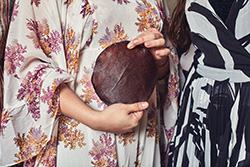Seven sustainable innovations from KTH researchers

Research from KTH contributes to real and lasting change in society. Here are seven sustainable projects that have come through the doors of KTH Innovation, all started by researchers at KTH.
Every year, KTH Innovation supports over 300 teams of students, researchers and employees at KTH who want to develop their ideas or commercialize their research. Here are seven projects that stand out in making things a bit more sustainable!
Re:newcell turns your old clothes into new fabric

It started with the idea of processing cellulose to produce glucose, based on research from the KTH School of Engineering Sciences in Chemistry, Biotechnology and Health. Since the team first contacted KTH Innovation in 2009, much has changed.
Now, Re:newcell turns used cotton and viscose into new biodegradable pulp, that can be turned into new fibers, new yarn, new fabrics and new garments that can be produced and worn again and again. In 2016, they opened the Re:newcell plant and became first in the world to produce top quality raw materials from textile waste on an industrial scale.
Finecell makes nanocellulose from wood
Based on research from the KTH School of Engineering Sciences in Chemistry, Biotechnology and Health, this team of researchers came up with a way of producing cellulosic micro-fibrils originating from the forest.
Lighter in weight, and produced through a green and energy-efficient process using only renewable chemicals make them more eco-friendly than traditional options. Now, your makeup or the paint you buy for your house could include Finecell nanocellulose!
Efficient manufacturing of metallic materials with HiMat
Not only can running a single test of a new material in a steel mill cost up to one million SEK; it also emits large volumes of greenhouse gases. Leveraging over 50 years of combined experience of metallic materials research, the team behind HiMat Engineering set out from their home base at the ITM school to find a more efficient way of developing and manufacturing metallic materials.
Their solution was HEDDA, a digital platform for data-driven materials development, where companies can conduct virtual experiments and optimize the materials’ performance to make their products more competitive. That’s what we call win-win for both the companies and the climate!
Airmee drastically reduces detours
We’re getting more and more used to the luxury of getting goods delivered right to our doorstep. Leveraging KTH research on transport and location analysis at the KTH School of Architecture and the Built Environment, Airmee has become one of the leading actors for last-mile delivery on the Stockholm market, and they come with a sustainable twist.
Their algorithm cuts down on unnecessary detours, leading to less CO2 emissions per transport. In 2019, they’ve taken it one step further, launching fossil free delivery in the city. Next time you see an Airmee delivery, make sure to give them a wave.
SKOPAS makes super sustainable batteries
What if batteries could be made from organic materials? That’s what’s in the works in the materials science lab at the KTH School of Industrial Engineering and Management. SKOPAS, currently one of the teams in the KTH Innovation pre-incubator program , is developing energy storage solutions based on harmless, abundant and fully recyclable materials, such as carbon and water. In the future, you could charge your batteries in seconds, and if they should ever break, just chuck them in the trash.
Stockholm Water lets you drink from the sea
Water shortage is an increasing issue around the world. Even in the Stockholm archipelago, inhabitants struggle to make water last for their everyday needs. That’s why people on the islands got to try using KTH technology to make sea water potable this summer. The solution - a low pressure, low cost and low energy electrochemical water desalination system based on Capacitive Deionization - was developed at the Department of Functional Materials at the KTH School of Engineering Sciences. Stockholm Water Technology’s solution could soon be used in agriculture, in off-grid areas, rural communities and on marine vessels across the globe.
KTH & Global Change Award help the shift towards sustainable fashion

In early April each year, five teams with ideas capable of reshaping the apparel industry arrive at KTH. They’re the winners of Global Change Award, come to Stockholm from around the world to claim their award, but also to start a year of development in an innovation accelerator. H&M Foundation founded this innovation challenge with the aim to make fashion circular to protect the planet and our living conditions.
KTH has been a partner since the start in 2015, with KTH Innovation taking lead in organizing the accelerator program in Stockholm. In the past years, we have seen everything from fabric made from grapes, oranges or food crop waste, to digital solutions that make it possible to trace the materias in the clothes you wear. Find out more at globalchangeaward.com .

